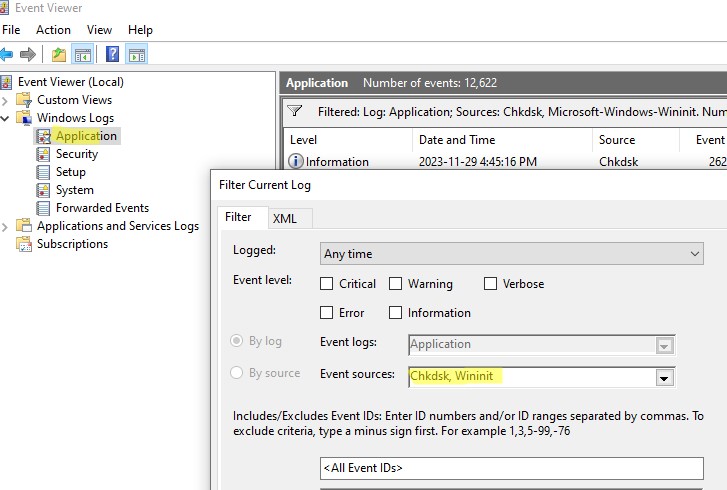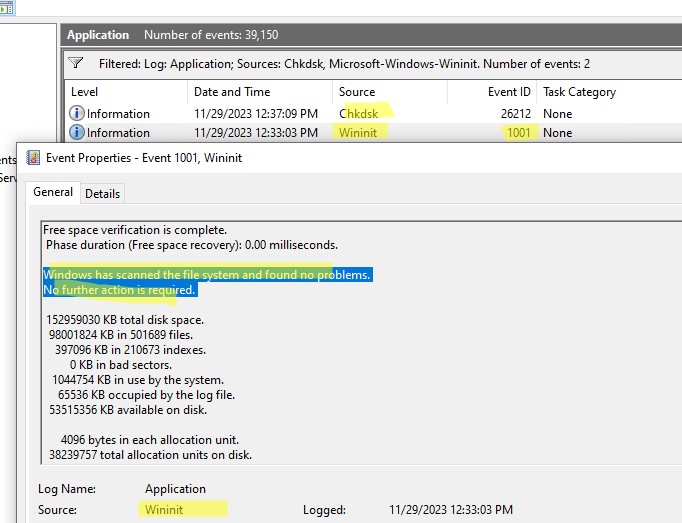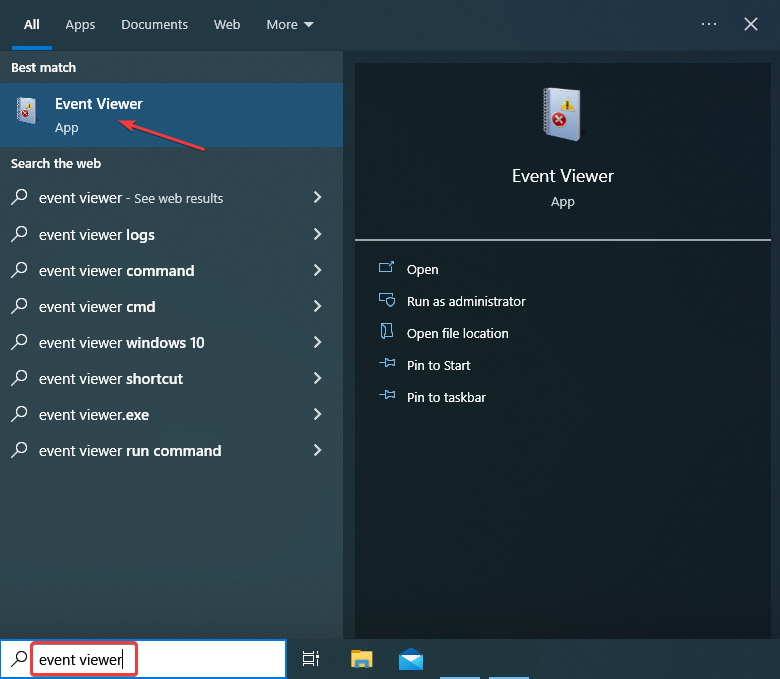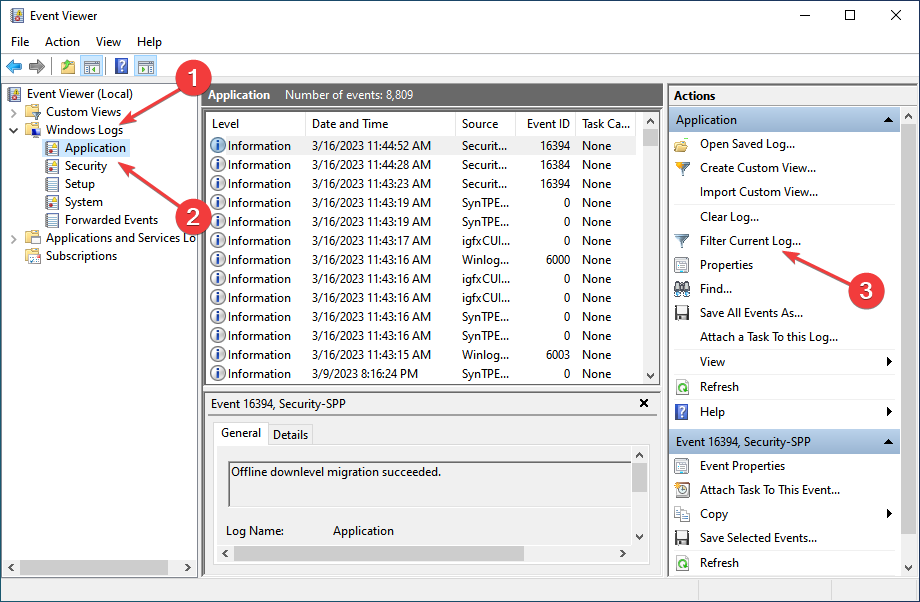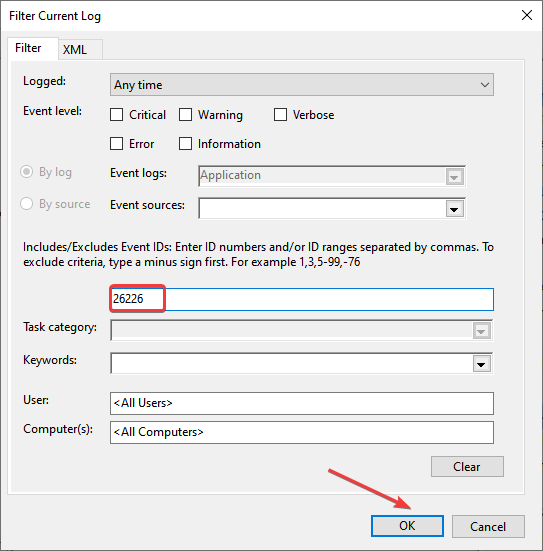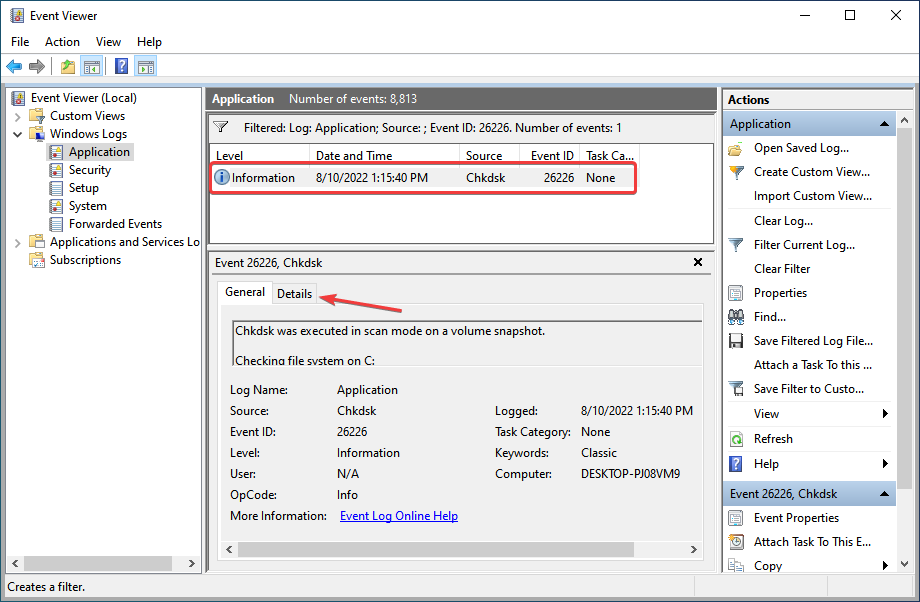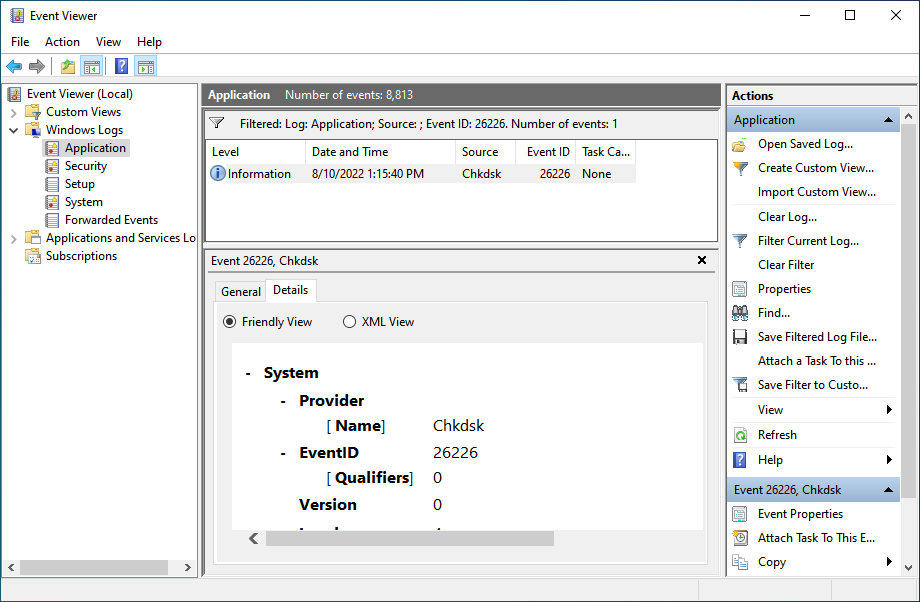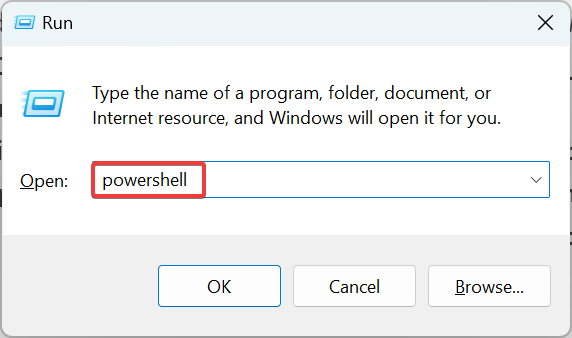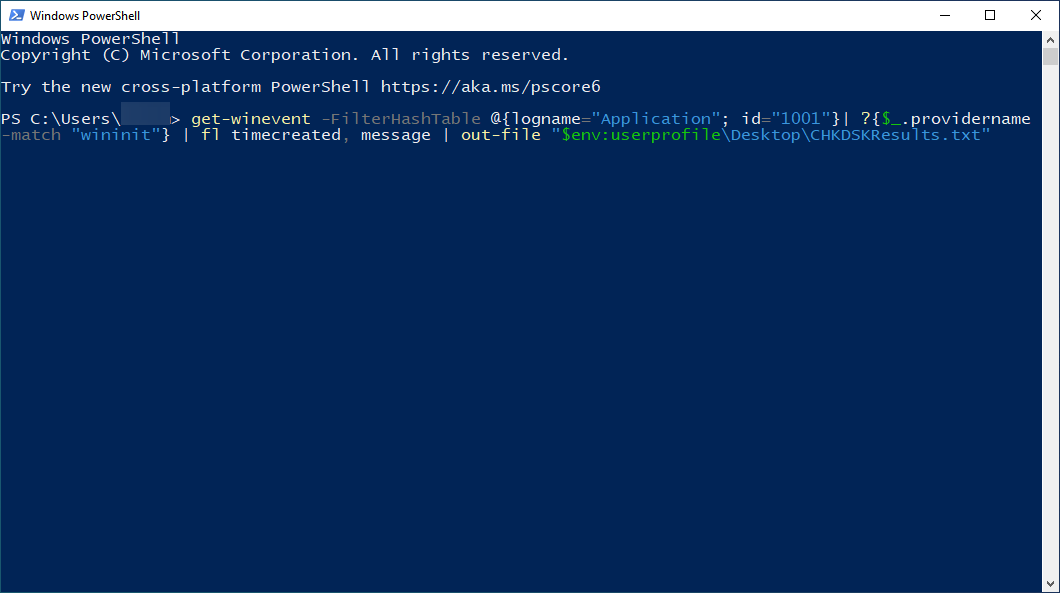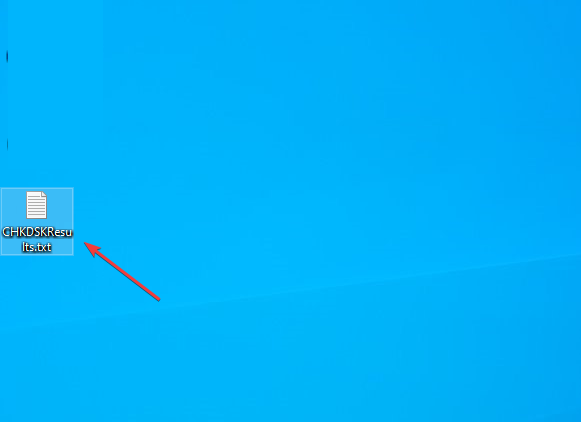Встроенная утилита CHKDSK.exe (check disk) используется в Windows для проверки диска на ошибки. Сhkdsk проверяет файловую систему на физические и логические ошибки, находит поврежденные секторы (bad sectors) и исправляет найденные проблемы.
Содержание:
- Проверка и восстановление диска с помощью команды chkdsk
- Просмотр результатов проверки Chkdsk в Windows
Проверка и восстановление диска с помощью команды chkdsk
Чтобы проверить жесткий диск на ошибки, запустите командную строку с правами администратора и выполните:
chkdsk E: /F /R
Данная команда:
- Выполнит проверку диска E:\
- Исправит автоматически найденные ошиьки (/F)
- Попытаться восстановить данные при обнаружении поврежденных секторов, она попытается восстановить информации (/R).
Полная проверка диска может занять длительное время в зависимости от емкости носителя и количества файлов. После окончания проверки диска вы увидите подробную статистику диска, информацию о поврежденных секторах и файлах, предпринятых действиях по восстановлению.
Если утилита chkdsk не обнаружила проблем на диске, появится сообщение:
Windows has scanned the file system and found no problems. No further action is required.
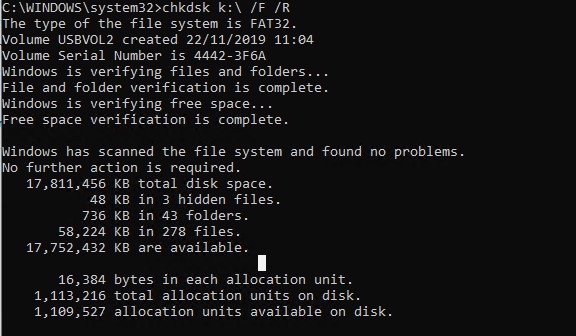
Утилита chkdsk не позволяет выполнить online проверку системного диска (C:\). При запуске команды chkdsk C: /F /R появится уведомление:
Cannot lock current drive. Chkdsk cannot run because the volume is in use by another process. Would you like to schedule this volume to be checked the next time the system restarts? (Y/N).
Невозможно выполнить команду Chkdsk, так как указанный том используется другим процессом. Следует ли выполнить проверку этого тома при следующей перезагрузке системы?
Чтобы запланировать проверку диска при следующей загрузке Windows, нажмите
Y
->
Enter
.
This volume will be checked the next time the system restarts
.

Чтобы отменить запланированную проверку диска, выполните:
chkntfs /x c:
Чтобы отключить топ перед проверкой, добавьте атрибут /X в команде chkdsk. В этом случае Windows принудительно закрое все открытые файловые дескрипторы, отмонтирует диск и выполнит проверку на ошибки.
Если вам нужно выполнить проверку большого NTFS тома, но вы не хотите блокировать диск, можно сначала просканировать диск на ошибки:
chkdsk E: /f /offlinescanandfix
Утилита найдет ошибки и сохранит их в файл $corrupt для дальнейшего исправления
Чтобы исправить найденные ошибки, не тратя время на полное сканирование тома, выполните:
chkdsk D: /spotfix
Это существенно сократит время недоступности тома для пользователя при исправлении ошибок.
В консоли PowerShell для проверки диска можно использовать командлет Repair-Volume как аналог команды chkdsk:
Repair-Volume -driveletter C -scan
Также рекомендуем перед проверкой проверить SMART состояние жестких дисков с помощью встроенных PowerShell командлетов из модуля управления дисками:
Get-PhysicalDisk | Sort Size | FT FriendlyName, Size, MediaType,SpindleSpeed, HealthStatus, OperationalStatus -AutoSize

Просмотр результатов проверки Chkdsk в Windows
Chkdsk при онлайн сканировании диска выводит результаты прямо в консоль. Если вы запланировали проверку диска при загрузке Windows, то результаты можно получить только из журнала событий Windows (Event Viewer).
- Откройте консоль Event Viewer (
Eventvwr.msc
) и перейдите в раздел Windows Logs -> Application; - Щелкните правой клавишей по разделы Application и выберите Filter Current Log. В поле Event Source выберите Chkdsk и Wininit и нажмите ОК;
- Подробные результаты проверки диска содержатся в описании события. Обратите внимание, что у онлайн событий проверки диска будет указан источник Chkdsk. Если выполнялась офлайн проверка диска при загрузке Windows, у такого события будет источник Wininit и EventID 1001.
Можно получить лог проверки диска с помощью PowerShell командлета Get-WinEvent. Например, чтобы выгрузить результаты последних 5 проверок диска в текстовый файл CHKDSK_SCAN.txt на рабочем столе, выполните команду:
Get-WinEvent -FilterHashTable @{logname="Application"; id="1001"}| ?{$_.providername –match "wininit"} | fl timecreated, message| out-file $home\Desktop\CHKDSKResults.txt
Открыть полученный файл с логом chkdsk:
notepad.exe $home\Desktop\CHKDSKResults.txt
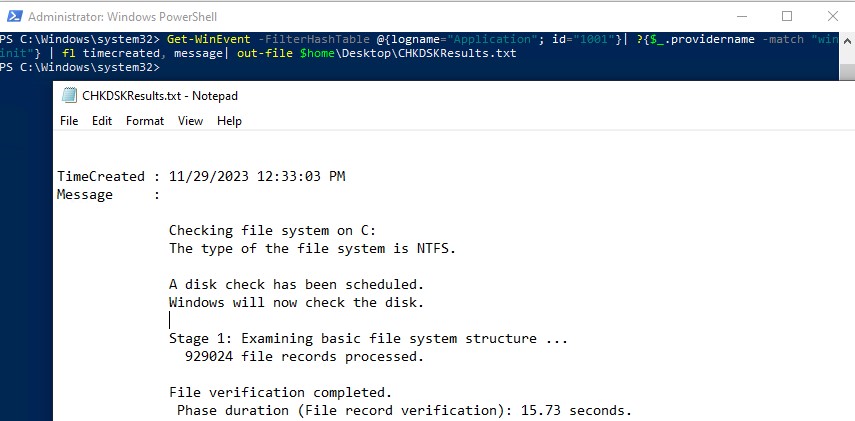
Если размер лога Chkdks очень большой, журнал событий может обрезать его. В этом случае можно открыть полный лог проверки диск в System Volume Information. Чтобы получить доступ к этой папке, нужно запустить командную строку от имени SYSTEM (проще всего с помощью утилиты psexec):
.\PsExec.exe -i -s cmd.exe
После этого можно открыть лог chkdsk:
notepad.exe "c:\System Volume Information\Chkdsk\Chkdsk20231129072214.log"
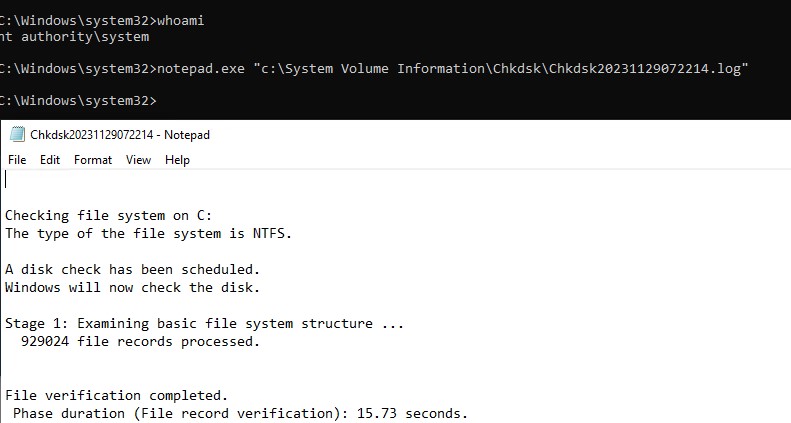
Readers help support Windows Report. We may get a commission if you buy through our links.
Read our disclosure page to find out how can you help Windows Report sustain the editorial team. Read more
Chkdsk or Check Disk is a built-in utility for disk repairs in Windows and is often the first used by users. After each scan, it creates a log file detailing the collected information. This concerns users and they have been asking where are Chkdsk logs stored in Windows 10.
The log files are critical for various reasons, whether to identify or eliminate the problem. And that cannot be done until you can access the log file in a readable format. That’s what we will be helping you with today. So, let’s find out the Chkdsk log file location in Windows 7 and later iterations.
What is the location of chkdsk logs?
If you have been trying to figure out where the Chkdsk logs are stored in Windows 10, it’s the System Volume Information folder on the system drive, usually the C: drive. The folder also contains other critical information and is the Chkdsk log location in Windows 11 as well.
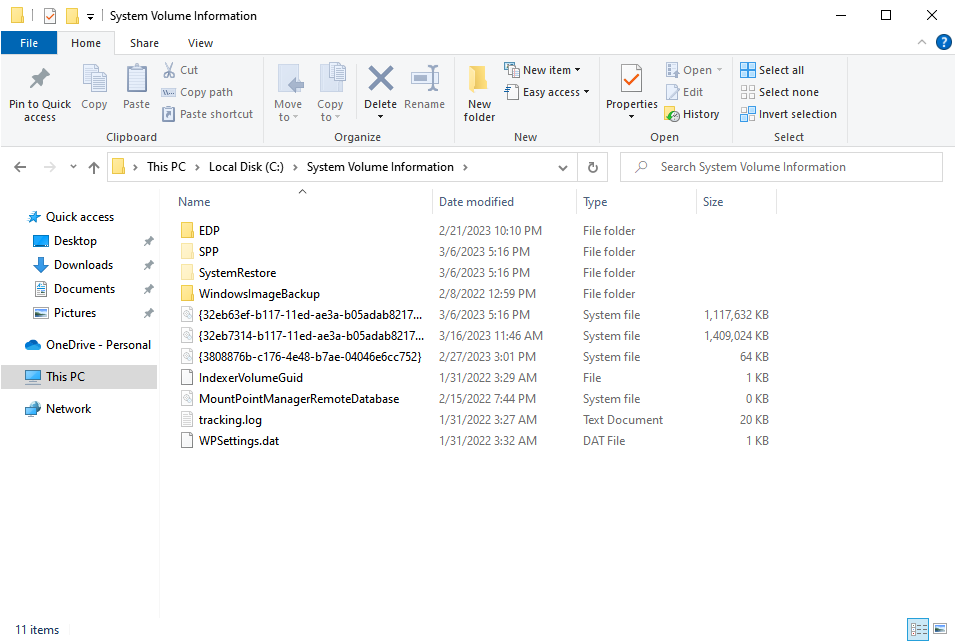
But you can’t access the Chkdsk logs in File Explorer since the files here are protected and not accessible under default settings. Also, we don’t recommend changing these since you can have Chkdsk output to file or view them in the Event Viewer. Let’s find out how.
How do I view Chkdsk logs in Windows 10?
1. With Event Viewer
- Press Windows + S to open the Search menu, type Event Viewer in the text field, and click on the relevant result.
- Expand Windows Logs from the navigation pane, select Applications under it, and then click on Filter Current Log on the right.
- Enter 26226, the event ID for Check Disk, in the All Event IDs text field, and click OK.
- All the Chkdsk logs will now be listed. You can click on one to see a brief overview in the General tab or head to the Details tab for a comprehensive result.
- You can now view the Chkdsk log in Friendly View and XML View.
Using the Event Viewer to view Chkdsk logs is probably the simplest way. But if you find that Chkdsk log is not in Event Viewer, there’s another method to export the file.
2. Via PowerShell
- Press Windows + R to open Run, type powershell in the text field, and then hit Enter.
- Click Yes in the UAC prompt.
- To export the Chkdsk log as a text file to the desktop, execute this command:
get-winevent -FilterHashTable @{logname="Application"; id="1001"}| ?{$_.providername -match "wininit"} | fl timecreated, message | out-file "$env:userprofile\Desktop\CHKDSKResults.txt" - Go to the desktop, and open the CHKDSKResults.txt file to view the logs.
That’s it! You now know where are Chkdsk logs stored in Windows 10, how to access them, and view the detailed results. Also, the same information applies to the Chkdsk log file location on Windows Server 2012; you can access these from the Event Viewer.
And while you are here, do not forget to check some quick tips to improve your PC’s performance.
For any other questions and suggestions, don’t hesitate to reach for the comments section below.
Matthew Adams
Windows Hardware Expert
Matthew is a freelancer who has produced a variety of articles on various topics related to technology. His main focus is the Windows OS and all the things surrounding it.
He is passionate about the tech world, always staying up-to-date with the latest and greatest. With an analytical view, he likes problem-solving, focusing on errors and their causes.
In his free time, he likes to read and write about history and tries to always develop new skills.
-
Home
-
News
- How to Open Chkdsk Log Windows 10? – 2 Ways
By Tina |
Last Updated
Chkdsk is a very common tool to check disk when there are problems on the hard drive. However, after running the chkdsk command, do you know where the chkdsk log is located or do you know how to find the chkdsk log location? This post from MiniTool will show you 2 ways to find chkdsk log Windows 10.
Chkdsk, also known as the check disk, is a Windows built-in tool. You can run the chkdsk tool via the Command Line window or with the Scan Disk option in Windows. The chkdsk might also start scanning automatically during system boot-up from some users.
The chkdsk tool is used to scan the file system of the hard drive on your laptop or desktop computers. If it finds the file system errors, it will repair them. In addition, the chkdsk tool can also be used to scan and repair the bad sectors on hard drive. Therefore, the chkdsk tool is a system maintenance utility.
2 Ways to Open Chkdsk Log Windows 10
Chkdsk retains the logs that provide an overview of the scans and any fixes applied. In general, the chkdsk log location is in the System Volume Information folder on the C drive. However, the System Volume Information is a concealed folder and it will not be displayed on the File Explorer.
Meanwhile, if you want to see the chkdsk log Windows 10, what can you do? Hence, in the following section, we will show you how to view the chkdsk log.
Open Chkdsk Log via Event Viewer
1. Type Event Viewer in the search box of Windows and choose the best-matched one.
2. Then open it.
3. In the pop-up window, select Windows Logs > Application on the left panel to continue.
4. On the right panel, choose Filter Current Log.

5. In the pop-up window, enter 26226 in the All Event IDs text box.
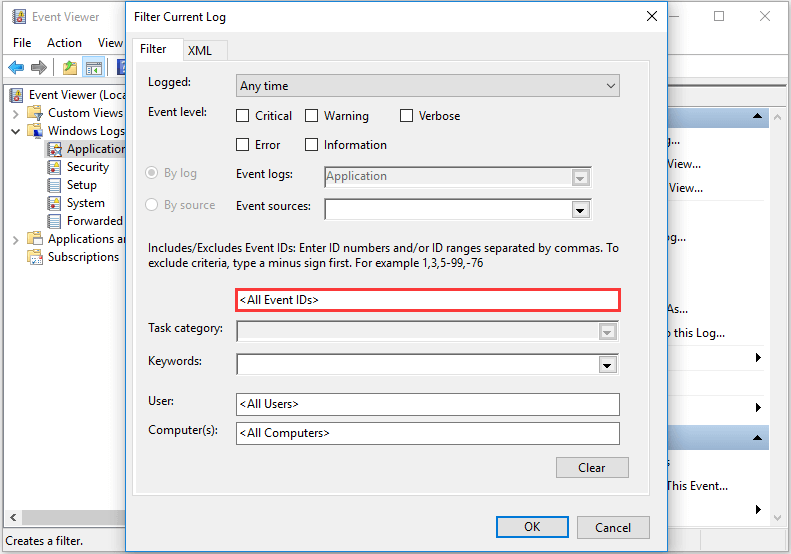
6. Click OK to continue.
7. After that, click information to view chkdsk log details.
So, in order to view the chkdsk log Windows 10, you can try the above instructions.
Open Chkdsk Log via PowerShell
Besides viewing chkdsk log via Event Viewer, you can also choose to open chkdsk log via PowerShell.
Now, here is the tutorial.
- Open PowerShell as administrator.
- Then input this command to display the latest chkdsk log in PowerShell: get-winevent -FilterHashTable @{logname=”Application”; id=”1001″}| ?{$_.providername –match “wininit”} | fl timecreated, message and hit Enter to continue.
- In order to get a text file of that chkdsk log, type the following command: get-winevent -FilterHashTable @{logname=”Application”; id=”1001″}| ?{$_.providername –match “wininit”} | fl timecreated, message | out-file DesktopCHKDSKResults.txt and hit Enter to continue.
With this method, you can view the chkdsk log in the PowerShell window or choose to export the chkdsk log as a text file. So, you can choose either of them to view chkdsk log Windows 10. These chkdsk logs will show you the five stages of the check disk scans and any fixes applied to the file system.
Final Words
In conclusion, the chkdsk tool is a Windows built-in tool which can be used to scan and repair corrupted file systems or bad sectors on hard drive. If you want to know what fixes have been applied to the system, you can open chkdsk log. This post has shown two 2 ways to open chkdsk log Windows 10.
About The Author
Position: Columnist
Tina is a technology enthusiast and joined MiniTool in 2018. As an editor of MiniTool, she is keeping on sharing computer tips and providing reliable solutions, especially specializing in Windows and files backup and restore. Besides, she is expanding her knowledge and skills in data recovery, disk space optimizations, etc. On her spare time, Tina likes to watch movies, go shopping or chat with friends and enjoy her life.
Chkdsk (Check Disk) utility is one of the most Populaire Windows utilities. Chkdsk is the utility everyone uses to repair bad disk sectors and corrupted system files.
‘’Chkdsk’’ can be run manually from the command line and automatically, by the operating system during the boot, to check the drives that need a consistency check.
When you run Chkdsk from the command line, the disk check results will be displayed just after the utility ends scanning the disk;
The question, though, is where to find Chkdsk results after you exit the command line Window?

Find Chkdsk results in the event viewer
1. Find Chkdsk command-line results
The Chkdsk scan results are recorded in the applications event log;
- Open the event viewer;
- Click on the application log;
- On the ‘’Actions’’ panel, click on the ‘’Filter current Log…’’;
- In the Filter box, select ‘’Chkdsk’’ from the Event sources’ dropdown box;

2. Find Autochk results
Autochk.exe is the boot-time version of Chkdsk; that runs during the system boot to check drives consistency.
- Open the event viewer;
- Click on the application log;
- On the ‘’Actions’’ panel, click on ‘’Filter current Log…’’
- In the Filter box, select ‘’Wininit’’ from the Event sources’ dropdown box;

3. Simplify the search process
You can make your life easier by having the Chkdsk results available without having to do searches and filtering;
- Open the event viewer;
- Click on the application log;
- On the ‘’Actions’’ panel, click on ‘’Filter current Log…’’
- In the Filter box, select ‘’Chkdsk’’ and ‘’Wininit’’ from the Event sources’ dropdown box;

- On the Actions panel, click on ‘’Save Filter to Custom View…’’;
- Give your custom filter a name and click Ok;
Please leave a comment below and share this article on your preferred social media platform, so that other persons can benefit.
Related
Chkdsk (short for Check Disk) is a built-in Windows utility used to scan and fix errors on a hard drive or other storage device. Chkdsk automatically creates a log file during the scan process, which contains detailed information about the scan and any errors or issues found.
In Windows 10, the Chkdsk log file is typically located in the Event Viewer. To access the Chkdsk log file:
1. Press the Windows key + R to open the Run command box.
2. Type “eventvwr.msc” (without quotes) and press Enter.
3. In the Event Viewer window, expand the “Windows Logs” section in the left-hand pane.
4. Click on “Application” to see all application-related events.
5. Look for “Wininit” under the “Source” column on the right-hand side and click on it.
6. Look for the most recent “Checking file system” entry and double-click on it to open the log.
Alternatively, you can also find the Chkdsk log file by navigating to the following file path: %windir%System32winevtLogsApplication.evtx
From there, locate the most recent “Wininit” entry and click on it to see the Chkdsk log.
Video Tutorial:How do I find my chkdsk log?
How do I fix chkdsk errors in Windows 10?
When Windows 10 encounters problems with its file system or hard drive, it may perform a chkdsk (check disk) scan during boot-up to identify and fix errors. If chkdsk is unable to repair the errors, it’s necessary to perform additional troubleshooting.
Here are some steps you can take to fix chkdsk errors in Windows 10:
1. Open the Command Prompt with administrative privileges by pressing the Windows key + X and selecting “Command Prompt (Admin)”.
2. Type “chkdsk C: /f /r /x” into the Command Prompt and press Enter. This command will scan your C: drive for errors, attempt to repair them, and force a dismount of the drive if necessary.
3. If prompted, enter “Y” to schedule a chkdsk scan during the next boot-up.
4. Restart your computer to initiate the chkdsk scan.
5. Wait for the scan to complete. This can take several hours depending on the size and health of your hard drive.
6. If chkdsk is still unable to fix the errors, you may need to perform additional troubleshooting steps, such as using a disk repair tool or reinstalling Windows 10.
It’s important to regularly perform routine maintenance, such as disk cleanup and defragmentation, to prevent file and drive errors from occurring in the first place.
How do I find chkdsk results in Windows 11?
To find chkdsk results in Windows 11, you need to open the Event Viewer tool by searching for it in the Start menu or by using the Run dialog box (pressing Windows key + R). Once the tool is opened, navigate to the “Windows Logs” section and select “Application.” You should be able to see an event labeled “Wininit” – this event holds information about the chkdsk scan. Double-click on the event to open its details, and scroll down to view the results of the chkdsk scan and any errors or issues that were found. If you’re having trouble finding the chkdsk results, you can also use the command line interface by typing “eventvwr” into the Run dialog box to open the Event Viewer tool, or by using the “chkdsk” command with the “/v” parameter to display the results directly in the command prompt.
How do I run chkdsk in recovery mode?
To run chkdsk in Recovery Mode, follow the below steps:
1. Shut down your computer if it’s not already turned off.
2. Turn on your computer and immediately press the F11 key repeatedly until the “Advanced Startup Options” screen appears.
3. Select “Troubleshoot” from the options and then click on “Advanced Options”.
4. Click on “Command Prompt”.
5. When the Command Prompt opens, type “chkdsk /r” (without quotes) and then press Enter.
6. Chkdsk will scan your drive and attempt to repair any errors it finds.
It’s important to note that running chkdsk can take some time depending on the size of your drive, so be patient and let it complete the process.
Where are the old chkdsk files stored?
CHKDSK or Check Disk is a utility tool used by Windows operating system to scan and repair disk errors. When you run CHKDSK on a drive, it creates a log file for every scan it performs. These log files store information about the errors found on the disk, the status of the repair process, and other useful details.
The location of the CHKDSK log files depends on the version of Windows you are using. In Windows 10 and 8, the log files are stored in the “C:WindowsLogsWindows” directory. In Windows 7 and earlier versions, the log files can be found in the “C:WindowsChkdsk.log” or “C:WindowsChkdsk.txt” directory.
Keep in mind that CHKDSK log files tend to become very large, so it’s a good idea to save them to an external hard drive or cloud storage if you don’t need them for immediate troubleshooting purposes.
Is disk error checking the same as chkdsk?
Disk error checking and chkdsk are similar concepts, but they are different in some ways. Disk error checking is a feature in the Windows operating system that scans the hard drive for errors and corrects them automatically. Chkdsk, on the other hand, is a specific utility program within the Windows operating system which can be used to perform more advanced disk error checking and repair tasks.
Chkdsk can be run on any mounted volume within the operating system, and it can perform checks for various errors like bad sectors, cross-linked files, and lost clusters. Additionally, chkdsk can fix these errors, and it can also recover data from corrupted or unreadable files.
So while disk error checking is a more basic feature of the operating system, chkdsk is a more advanced tool that can be used to perform more specialized tasks when diagnosing and repairing hard drive issues.
{“@context”:”https://schema.org”,”@type”:”FAQPage”,”mainEntity”:[{“@type”:”Question”,”name”:”How do I fix chkdsk errors in Windows 10?”,”acceptedAnswer”:{“@type”:”Answer”,”text”:”When Windows 10 encounters problems with its file system or hard drive, it may perform a chkdsk (check disk) scan during boot-up to identify and fix errors. If chkdsk is unable to repair the errors, it’s necessary to perform additional troubleshooting. nnHere are some steps you can take to fix chkdsk errors in Windows 10: nn1. Open the Command Prompt with administrative privileges by pressing the Windows key + X and selecting “Command Prompt (Admin)”. nn2. Type “chkdsk C: /f /r /x” into the Command Prompt and press Enter. This command will scan your C: drive for errors, attempt to repair them, and force a dismount of the drive if necessary. nn3. If prompted, enter “Y” to schedule a chkdsk scan during the next boot-up. nn4. Restart your computer to initiate the chkdsk scan. nn5. Wait for the scan to complete. This can take several hours depending on the size and health of your hard drive. nn6. If chkdsk is still unable to fix the errors, you may need to perform additional troubleshooting steps, such as using a disk repair tool or reinstalling Windows 10. nnIt’s important to regularly perform routine maintenance, such as disk cleanup and defragmentation, to prevent file and drive errors from occurring in the first place.”}},{“@type”:”Question”,”name”:”How do I find chkdsk results in Windows 11?”,”acceptedAnswer”:{“@type”:”Answer”,”text”:”To find chkdsk results in Windows 11, you need to open the Event Viewer tool by searching for it in the Start menu or by using the Run dialog box (pressing Windows key + R). Once the tool is opened, navigate to the “Windows Logs” section and select “Application.” You should be able to see an event labeled “Wininit” – this event holds information about the chkdsk scan. Double-click on the event to open its details, and scroll down to view the results of the chkdsk scan and any errors or issues that were found. If you’re having trouble finding the chkdsk results, you can also use the command line interface by typing “eventvwr” into the Run dialog box to open the Event Viewer tool, or by using the “chkdsk” command with the “/v” parameter to display the results directly in the command prompt.”}},{“@type”:”Question”,”name”:”How do I run chkdsk in recovery mode?”,”acceptedAnswer”:{“@type”:”Answer”,”text”:”To run chkdsk in Recovery Mode, follow the below steps:nn1. Shut down your computer if it’s not already turned off.n2. Turn on your computer and immediately press the F11 key repeatedly until the “Advanced Startup Options” screen appears.n3. Select “Troubleshoot” from the options and then click on “Advanced Options”.n4. Click on “Command Prompt”.n5. When the Command Prompt opens, type “chkdsk /r” (without quotes) and then press Enter.n6. Chkdsk will scan your drive and attempt to repair any errors it finds.nnIt’s important to note that running chkdsk can take some time depending on the size of your drive, so be patient and let it complete the process.”}},{“@type”:”Question”,”name”:”Where are the old chkdsk files stored?”,”acceptedAnswer”:{“@type”:”Answer”,”text”:”CHKDSK or Check Disk is a utility tool used by Windows operating system to scan and repair disk errors. When you run CHKDSK on a drive, it creates a log file for every scan it performs. These log files store information about the errors found on the disk, the status of the repair process, and other useful details.nnThe location of the CHKDSK log files depends on the version of Windows you are using. In Windows 10 and 8, the log files are stored in the “C:WindowsLogsWindows” directory. In Windows 7 and earlier versions, the log files can be found in the “C:WindowsChkdsk.log” or “C:WindowsChkdsk.txt” directory.nnKeep in mind that CHKDSK log files tend to become very large, so it’s a good idea to save them to an external hard drive or cloud storage if you don’t need them for immediate troubleshooting purposes.”}},{“@type”:”Question”,”name”:”Is disk error checking the same as chkdsk?”,”acceptedAnswer”:{“@type”:”Answer”,”text”:”Disk error checking and chkdsk are similar concepts, but they are different in some ways. Disk error checking is a feature in the Windows operating system that scans the hard drive for errors and corrects them automatically. Chkdsk, on the other hand, is a specific utility program within the Windows operating system which can be used to perform more advanced disk error checking and repair tasks. nnChkdsk can be run on any mounted volume within the operating system, and it can perform checks for various errors like bad sectors, cross-linked files, and lost clusters. Additionally, chkdsk can fix these errors, and it can also recover data from corrupted or unreadable files.nnSo while disk error checking is a more basic feature of the operating system, chkdsk is a more advanced tool that can be used to perform more specialized tasks when diagnosing and repairing hard drive issues.”}}]}

